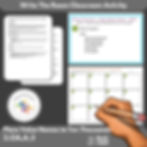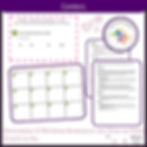Creating strong Individualized Education Program (IEP) goals for writing is essential for ensuring that students with disabilities receive the support they need to improve their writing skills. These goals should be aligned with grade-level standards and backward scaffolded to the student's current performance level. By setting clear, measurable objectives, educators can track progress and address specific needs effectively.

Key Details
Grade-Level Standards: IEP goals should be based on the student's grade level standards, with objectives scaffolded to their current performance.
Progress Monitoring: Writing goals should show reliable progress over time, ensuring that the student's needs are adequately addressed.
IEP Team Collaboration: The IEP team, including parents, educators, and other professionals, plays a crucial role in developing individualized writing goals.
Developing IEP Goals and Objectives for Writing: Text Types and Purposes
Writing is a critical skill for success in school and beyond. Research has shown that different writing approaches work better for different types of learners, making it essential to break down writing requirements into smaller, manageable pieces.
The Role of the IEP Team
The IEP team is responsible for developing individualized writing goals that address the student's specific needs and abilities. A writing rubric is an essential tool for grading and ensuring accurate measurement of student progress.
For instance, tracking the development of a five-paragraph essay can be challenging if only a few skills are mastered. A rubric breaks down the task into smaller elements, making it easier to monitor progress and identify areas for improvement.
Writing Rubric and Feedback
Utilizing a writing rubric helps guide IEP goals for writing and ensures accuracy. Providing students with feedback on their work is crucial for helping them gauge their progress and identify target areas for improvement. As students master skills on the rubric, new targets can be set to continue their growth.
Objectives of Writing Skills
Written expression IEP goals cover various aspects such as grammar, vocabulary, sentence structure, paragraph development, organization, and coherence. These goals are collaboratively developed by the student, parents, educators, and other professionals on the IEP team.
As goals become more specific and complex, they build on foundational skills from previous grades. This continuity makes it easier to develop goals that align with standards from grades 2-5, providing a cohesive framework for skill development.

Example IEP Goals by Grade Level
Second Grade
Opinion writing at a second-grade level requires the student to:
Write an introduction to a topic or book
State an opinion about the topic
Supply reasons that support the opinion
Use linking words such as "because" and "also"
Write a concluding statement
Third Grade
Opinion writing at a third-grade level requires the student to:
Write an introduction to a topic
State an opinion about the topic
Create an organizational structure that lists reasons
Use linking words and phrases like "because," "therefore," "since," and "for example"
Write a concluding statement
Fourth Grade
Opinion writing at a fourth-grade level requires the student to:
Write an introduction with a clearly stated opinion
Create an organizational structure with reasons supported by facts and details
Link reasons and opinions with phrases like "for instance," "in order to," and "in addition"
Write a concluding statement related to the opinion
Fifth Grade
Opinion writing at a fifth-grade level requires the student to:
Write an introduction with a clearly stated opinion and an organizational structure
Provide logically ordered reasons supported by facts and details
Use linking words, phrases, and clauses like "consequently" and "specifically"
Write a concluding statement related to the opinion
Common Writing Assignments for Elementary School
Elementary school writing emphasizes opinion writing, informative/explanatory writing, and narrative writing. Assignments often include book reports, summaries, persuasive essays, and descriptions.
Sample IEP Goals for Written Expression
Developing IEP goals for written expression involves various components of the writing process, such as pre-writing, drafting, revising, editing, reteaching/scaffolding, and fluency. These goals are specific, measurable, achievable, relevant, and time-bound (SMART) and address individual needs and abilities.
Higher Order Components
Higher-order components of writing include planning, transcribing (drafting), reviewing, and modifying. Each step involves specific skills:
Planning: Thinking ahead and organizing ideas
Transcribing (Drafting): Writing the initial draft with analysis and synthesis
Reviewing: Checking for errors and coherence
Modifying: Making improvements to the writing
Sample Pre-Writing and Revising IEP Goals
Pre-Writing Goals:
By (date), when given ten note cards, write a sequenced five-paragraph essay outline.
By (date), when given a storyboard, organize thoughts to write a sequenced five-paragraph essay outline.
Revising Goals:
By (date), when given a revision assignment, rewrite sentences for clarity and grammar correction.
By (date), delete unnecessary words to improve sentence clarity.
Sample Goals for Writing Complete Sentences and Paragraphs
Complete Sentences Goals:
By (date), when given a sentence prompt, write complete sentences with proper grammar and punctuation.
By (date), when given a list of vocabulary words, use them to write complete sentences that demonstrate correct usage.
Five Sentence Paragraph Goals:
By (date), when given a topic sentence, write a five-sentence paragraph including at least three supporting details and a concluding sentence.
By (date), when given a graphic organizer, use it to outline and write a five-sentence paragraph on a given topic.
Enhancing Fine Motor Skills, Writing Fluency, and Reading Skills
IEP goals should also address fine motor skills, writing fluency, and reading skills. These areas are crucial for overall academic success and support the development of strong writing abilities.
Fine Motor Skills Goals:
By (date), improve fine motor skills by practicing handwriting exercises three times a week.
By (date), enhance coordination by completing activities such as cutting shapes or tracing lines.
Writing Fluency Goals:
By (date), increase writing fluency by practicing writing for ten minutes each day, focusing on speed and accuracy.
By (date), improve fluency by participating in timed writing exercises that focus on producing coherent sentences quickly.
Reading Skills Goals:
By (date), improve reading comprehension by reading and summarizing one paragraph daily.
By (date), enhance vocabulary by learning and using five new words each week in writing assignments.

Leveraging Student's Strengths and Teacher Observations
When developing IEP goals, it's essential to consider the student's strengths and use regular progress monitoring to ensure the student makes progress. Teacher observation plays a crucial role in this process, providing valuable insights into the student's abilities and areas for improvement.
Writing IEP goals for students with disabilities involves focusing on higher-order skills of planning, transcribing, reviewing, and modifying. By incorporating measurable IEP goals with clearly defined writing skills, students will gradually develop independence in reading fluency and comprehension. Regular progress monitoring and leveraging the student's strengths ensure that students improve over time, making significant strides in their writing abilities.
Thank you for taking the time to read this article. I hope it has provided valuable insights into creating effective IEP goals and objectives for writing. Your feedback and questions are always welcome, so please don't hesitate to leave a comment below. I'm here to help!
































